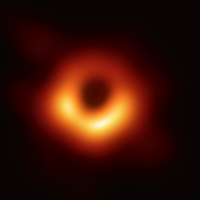
By: Maunakea Observatories
On April 10, 2019, Governor David Y. Ige of the State of Hawai'i issued a proclamation declaring the day "Pōwehi Day" in recognition of the release of the world's first-ever image of a black hole by the Event Horizon Telescope (EHT) collaboration. The proclamation also noted the critical role of two Maunakea Observatories -- the James Clerk Maxwell telescope (JCMT) and Submillimeter Array (SMA) -- the proposed Hawaiian name of Pōwehi and the international commitment of visionaries and scientists to furthering the world's understanding of the universe.
Hawai'i's JCMT and SMA, who pioneered black hole study decades ago, joined 6 other radio telescopes across the globe in equally unique locations to capture the stunning image of the supermassive black hole. Astronomers worked with renowned cultural practitioner and Hawaiian language expert Dr. Larry Kimura to propose the name of Pōwehi to the EHT collaboration for consideration.
Pōwehi, a name sourced from the Kumulipo, the sacred primordial chant describing the creation of the Hawaiian universe, means "embellished fathomless dark creation," connecting this modern day feat of science to ancient Hawaiian tradition and naming practices that extend back thousands of years. Currently under consideration, the name "Pōwehi" adds an indigenous perspective to modern day science, helping audiences grasp the significance of global discoveries and make sense of what it means for them, their communities and the world.
About Maunakea Observatories
The Maunakea Observatories are a collaboration of nonprofit independent institutions with telescopes located on Maunakea on the island of Hawai'i. Together, the Observatories make Maunakea the most scientifically productive site for astronomy world-wide.
The telescopes on Maunakea are operated by 12 separate nonprofit observatories. Each has its own strengths with varying fields of view and sensitivities to light from radio to ultraviolet wavelengths. They are all important to the scientific productivity of Maunakea.
Numerous national and international astronomy organizations have come together to study on the summit of Maunakea, creating one of the world's largest ground-based astronomical research and observing sites. The remote location, clean air, dark skies, stable atmosphere, minimal cloud cover, and transparency of the atmosphere to infrared radiation make the summit of Maunakea ideal for astronomy. The combination of optical, infrared, and sub- millimeter wavelength telescopes provide synergy and opportunities to study the sky from multiple perspectives.
The 525-acre Astronomy Precinct encompasses eleven telescope facilities representing eight countries on Maunakea. Eight of them are for optical and infrared astronomy, two of them are for sub millimeter wavelength astronomy and one is for radio astronomy. They include four of the largest optical/infrared telescopes in the world (the two Keck telescopes, Subaru, and Gemini), the second-largest dedicated infrared telescope (UKIRT) and the world's largest submillimeter telescope (JCMT).
UH Hilo Astronomy Program
The UH Hilo astronomy program aims to develop the science knowledge and analytic skills of students, whether they be majors or not, through a focus on the field of astronomy; and instill an appreciation of science, particularly astronomy, in students. The program provides the students with transferable skills so they can excel in a wide range of STEM-related fields. Through the study of astronomy, graduates will also learn to appreciate and understand science more broadly, enabling them to be more informed citizens. The B.S. degree program, taking advantage of our access to Maunakea Observatories, provides the training needed for students seeking careers in astronomy---as professional astronomers, observatory technical staff, and educators. The program supports the liberal arts mission of the University of Hawai`i by providing general education courses in a field of major importance to the State of Hawai`i.
University of Hawai`i Institute for Astronomy
The Institute for Astronomy is a research institute within the University of Hawai`i at Manoa. It was founded in 1967 to manage the Haleakalā Observatories on Maui and the Mauna Kea Observatories on the Big Island, and to carry out its own program of fundamental research into the stars, planets, and galaxies that make up our Universe. It is one of the world's leading astronomical research centers. Its broad-based program includes studies of the Sun, planets, and stars, as well as interstellar matter, galaxies, and cosmology. Most IfA astronomers use the giant telescopes atop Mauna Kea and Haleakalā to collect faint visible light, including infrared and submillimeter radiation, from distant objects. In addition to astronomy research, IfA develops new technologies for use in ground-based and space-based observatories.
With a staff of over 60 Ph.Ds, IfA is one of the largest university astronomy programs in the world offering undergraduate, Masters and Doctorate degrees.
 By: Maunakea Observatories
By: Maunakea Observatories-Horizontal-P301-w1920.png)
